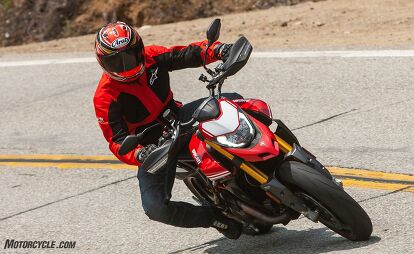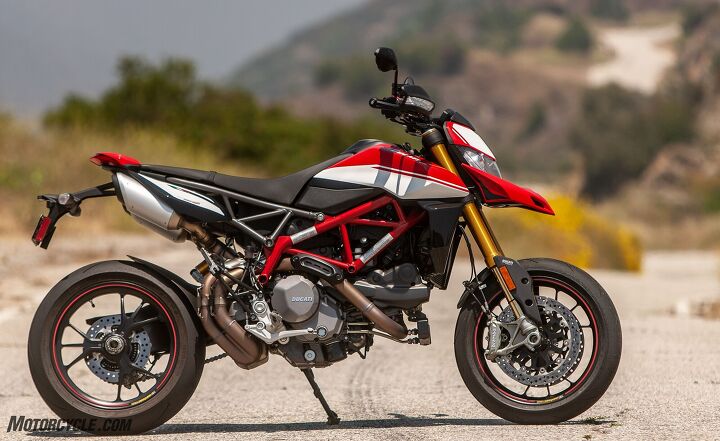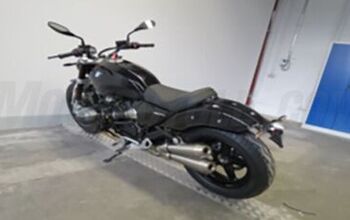Supermoto Two Ways

The Ducati Hypermotard 950 SP and KTM 690 SMC R prove theres more than one way to skin a cat
I’ve long maintained that riding a supermoto is one of my favorite forms of motorcycling. I’ve also maintained that I have no desire in owning one with headlights and a license plate. The reason is simple: they are one-way tickets to jail. The idea of a dirtbike – a small, nimble, light, and relatively powerful motorcycle made to jump over things – on road tires is batty. It’s an absolute riot, but it’s also batty and crazy. All this is a way to say I wouldn’t be able to control myself if one ended up in my hands. Which is why I relegate myself to riding supermoto on tracks, or when the occasional press bike comes my way.
The Breakdown
Which brings us to the Ducati Hypermotard 950 SP and KTM 690 SMC R – two very different interpretations on the supermoto-for-the-street theme. On the one hand, you have the Ducati Hypermotard. You can almost call it a caricature of a supermoto. With its trellis frame housing Ducati’s 937cc, 114 hp, Testastretta L-Twin, that’s already twice as many cylinders – and a heck of a lot more power – than a “normal” supermoto ( Aprilia’s SXV 450 and 550 notwithstanding). Hell, even if you were to lop one of those cylinders off, the 468cc jug you have left is still bigger than what you’ll find on most converted dirt bikes.
The top-shelf Öhlins and Brembo bits (on the SP model) wouldn’t necessarily be out of place on a traditional supermoto, but the single-sided swingarm sure is exotica. Speaking of exotica, electronic bits like a quick shifter, traction control, wheelie control, and ABS definitely qualify. In fact, the ABS even has a setting to help you slide into a corner, if you’re so inclined.
By contrast, the KTM 690 SMC R stays true to supermoto’s roots, at least compared to the Ducati. No surprise there as KTM’s a dirtbike company after all. First thing’s first – you’ve got a big ol’ thumper sitting in the middle, the way god intended. At 693cc it’s putting out a claimed 74 crank horsepower. It, too, is wrapped in a trellis frame with long-travel suspension at both ends; this one of the WP variety. The wire wheels are more inline with supermoto, but like the Ducati, the 690 SMC R’s throttle body is opened and closed electronically, which allows for techie things like traction control and different ride modes. Cornering-ABS is also part of the package, too. The purist might not call either bike a true supermoto, but I think it’s fair to say the KTM stays within the spirit.
What makes the KTM really stand out between the two is its 3.6-gallon fuel tank that doubles as the rear load-bearing subframe. In theory this helps save weight by having one component serve two purposes, but it also puts a varying amount of weight in a weird location.
What We’re Doing
If these two seem like an odd pairing, they are. Other than being from the same supermoto ilk, putting one against the other doesn’t entirely make sense. The whole supermoto-for-the-street thing never really caught on here in the US, which leaves us with relatively few examples to choose from. Still, we could have thrown in the Aprilia Dorsoduro 900 or the Husqvarna 701 Supermoto (which, let’s be honest, is almost the same bike as the 690 SMC R), but that’s not the point. The Ducati and KTM (and Aprilia and Husqvarna for that matter) represent two distinctly different flavors of the same drink. So, instead of a head-to-head, think of this more as a compare-and-contrast.
Johnny Burns gave us the lowdown on the Hypermotard when he attended the launch of both the Hyper and Hyper SP back in January, calling them “stupid-fun little motorcycles.” On the road, you sit so high up you have a commanding view of the road ahead, and the thing is narrow enough to easily split between cars and other traffic. Actually, you can say that about both bikes, especially since the KTM is even narrower than its Italian counterpart. If you live in a place where slicing…err…filtering between cars isn’t allowed, good luck holding back the temptation.
Both bikes can get up and move in irresponsible ways, but they go about their business very differently. With 100-plus horses and 70-odd lb-ft of torque, the Hypermotard’s two cylinders deliver a broad spread of power, perfect for its road-oriented environment. Ducati’s QuickShifter clicks easily in both directions, and you can be fairly lazy with your shifts since there’s enough torque to carry you along.
This is where the 690 feels more like a traditional supermoto. The Thumper gives you plenty of pop to get off the line, but its short gearing means you’re clicking through the cogs a lot more than the Ducati. This is just one clue the SMC R lives for the kart tracks and less so the open road. Another nod to the KTM’s dirt roots (actually, KTM’s origins were in street bikes, but that’s a topic for another time) is the fact the shifter is naturally placed a little high to put it in perfect position if you’re wearing MX boots. Neither motorcycle really vibrates much; not really surprising in a 90-degree V-Twin like the Ducati’s, but really surprising in the KTM. The Austrians combat the dreaded vibe in the 690 with two counterbalancers which are incredibly effective, even just humming along down the highway (pun not intended).
Of course, humming along is not what either motorcycle is meant for. No, both of these machines thrive when you’re searching for the limits of traction. The Hyper lives to embarrass sportbike riders with the ease, and speed, at which it can rail through medium- to high-speed corners and sweepers. You can simply charge to a corner, command the Brembo four-pots and twin 320mm discs to slow you down, flick down a few gears (without the clutch), then yank on the wide bars to put you where you want to go.
Meanwhile, the KTM thrives on the slow- to medium-speed twisties (again, like a kart track), where it can shoot out from tight corners. Before it can do that you first need to get to the corner. The short gearing plays well to tight environments, and grabbing a handful of the single Brembo 4-pot and 320mm disc is plenty to get the nose to dive and weight moved forward – a good thing as the rear subframe/fuel tank places a lot more weight towards the rear than I expected, compromising the balance of the bike. It’s possible some big changes in suspension settings could alleviate the imbalance, and possibly moving the adjustable fork offset to 22mm from its standard 24mm setting, but as it was, I didn’t have the confidence to really attack tight corners. Dirt riders gravitating toward the 690 will also like the fact you can sit right up front and stick your foot out in true dirt fashion, not something the Ducati lends itself to.
What Each Is Good For
We stated in the beginning that this isn’t a comparison test, which I’m sure begs the question: Then WTF are these bikes suited for, anyway? In the course of riding these two, it didn’t take long to figure out where each finds their rhythm. It comes down to this: If you’re looking for the more road-oriented supermoto, bikes like the Hypermotard and Aprilia Dorsoduro are ideal. Their bigger engines are less stressed at sustained highway speeds, their slightly wider seats are…well…slightly more comfortable for those times you’re not hauling ass, and they provide more creature comforts by way of electronic rider aids. Of course, when the time comes to shred rubber, the Hyper is equally capable, but the racetracks it prefers are road courses, not short kart tracks.
Conversely, those looking for a road-legal, track-oriented supermoto – and don’t want to go through the hassle of converting something else – will enjoy bikes like the 690 SMC R and Husqvarna 701 Supermoto. It’s a slick little motorcycle those with dirt roots will easily adapt to. All of its components are on equal footing as the Ducati’s, and not many motorcycles will keep up with it on really tight roads or kart tracks. The one caveat, and it’s a big one, is finding the right balance with the fuel tank’s rearward weight bias to suit your riding style.
Price-wise there’s not a lot between them, with the base Ducati Hypermotard starting at $13,295. The S model you see here is $16,695. Meanwhile, the KTM 690 SMC R comes in at $11,699.
So what’ll it be? That’s up to you to decide.
Troy’s In Gear

Helmet: Arai Corsair-X Nakagami 2 $882
- Jacket: Alpinestars Tailwind Air WP Jacket For Tech Air Street $400
- Pants: Alpinestars Crank Riding Jeans $250
- Gloves: Alpinestars SP-2 v2 Gloves $140
Boots: SP-1 Shoes (discontinued)
Ryan’s In Gear

Helmet: Shoei X-14 $860
- Jacket: REV’IT! Prometheus $480
- Pants: Alpinestars Crank Riding Jeans $250
- Gloves: REV’IT! Dominator GTX $270
Boots: Dainese Axial D1 Air $530
Specifications | 2019 Ducati Hypermotard 950 SP | 2019 KTM 690 SMC R |
|---|---|---|
| Engine | Testastretta 11°, L-Twin cylinder, 4 valve per cylinder, Desmodromic, liquid cooled, magnesium head covers | LC4 Single cylinder, 4 valve, SOHC, liquid-cooled, dual-spark |
| Displacement | 937cc | 693cc |
| Bore X stroke | 94.0 mm x 67.5 mm | 105.0 mm x 80.0 mm |
| Compression ratio | 13.3:1 | 12.7:1 |
| Horsepower | 114 hp at 9000 rpm (claimed) | 74 hp at 8000 rpm (claimed) |
| Torque | 71 lb-ft. at 7250 rpm (claimed) | 54 lb-ft. at 7250 rpm (claimed) |
| Fuel injection | Electronic fuel injection system, Ø 53 mm throttle bodies with full Ride by Wire system | Keihin EFI, 50 mm throttle bodies, Ride by Wire system |
| Exhaust | Double under-tail aluminum muffler; catalytic converter and two lambda probes. | Under-tail staineless steel muffler |
| Transmission | 6 speed | 6 speed |
| Final drive | Chain; Front sprocket 15; Rear sprocket 43 | Chain |
| Clutch | Slipper and self-servo wet multiplate clutch, hydraulic control | Power-assist clutch |
| Frame | Tubular steel Trellis frame | Chrome-moly tubular space frame, powder-coated |
| Front suspension | Öhlins fully adjustable, upside-down Ø 48 mm, 7.3 inches of travel | WP Suspension upside-down Ø 48 mm, with adjustable damping; 8.5 inches of travel |
| Rear suspension | Progressive linkage with fully adjustable Öhlins monoshock. Aluminium single-sided swingarm, 6.9 inches of travel | Progressive linkage with fully adjustable WP Suspension monoshock; 9.4 inches of travel |
| Front wheel | W shaped 3-spoke Marchesini forged light alloy 3.5″ x 17″ | Wire-spoke 17-inch wheels with CNC machined hub |
| Rear wheel | W shaped 3-spoke Marchesini forged light alloy 5.5″ x 17″ | Wire-spoke 17-inch wheels with CNC machined hub |
| Front Tire | Pirelli Diablo Supercorsa SP v3, 120/70 ZR17 | Bridgestone Battlax Hypersport S21 120/70 ZR17 |
| Rear Tire | Pirelli Diablo Supercorsa SP, 180/55 ZR17 | Bridgestone Battlax Hypersport S21 160/60 ZR17 |
| Front brake | 2 x 320 mm semi-floating aluminum flange discs, radially mounted Monobloc Brembo callipers, 4-piston 2-pad, radial pump with adjustable lever, with Bosch Cornering ABS | Brembo four piston, radially mounted caliper, brake disc Ø 320 mm; Bosch 9.1 MP cornering ABS |
| Rear brake | 245 mm disc, 2-piston calliper, with Bosch Cornering ABS | Brembo single piston floating caliper, brake disc Ø 240 mm; Bosch 9.1 MP cornering ABS |
| Instrumentation | Full-TFT color display | LCD display |
| Dry weight | 388 lb (claimed) | 324 lb (claimed) |
| Seat height | 35.0 inches | 35.0 inches |
| Wheelbase | 59.0 inches | 57.9 inches |
| Rake | 25° | 26.4° |
| Trail | 4.1 inches | 4.2 inches |
| Tank capacity | 3.8 US gallons | 3.6 US gallons |
| Electronics | Riding Modes, Bosch Cornering ABS, Ducati Traction Control (DTC) EVO, Ducati Wheelie Control (DWC) EVO, quickshifter | Riding Modes, Bosch Cornering ABS, traction control, quickshifter. |

Troy's been riding motorcycles and writing about them since 2006, getting his start at Rider Magazine. From there, he moved to Sport Rider Magazine before finally landing at Motorcycle.com in 2011. A lifelong gearhead who didn't fully immerse himself in motorcycles until his teenage years, Troy's interests have always been in technology, performance, and going fast. Naturally, racing was the perfect avenue to combine all three. Troy has been racing nearly as long as he's been riding and has competed at the AMA national level. He's also won multiple club races throughout the country, culminating in a Utah Sport Bike Association championship in 2011. He has been invited as a guest instructor for the Yamaha Champions Riding School, and when he's not out riding, he's either wrenching on bikes or watching MotoGP.
More by Troy Siahaan


















































































Comments
Join the conversation
We've got both kinds, Country and Western!
You guys never mentioned the long-standing Suzuki DR-400SM. It's even got SM in the name. Not all Supermotards (snicker!) are Eye-talian or Aussie (trian).
These bikes both really appeal to me (my current ride is an old first-generation Duke). A comparison I wonder about is the old air-cooled 796 Hypermoto and the FZ/MT-07, since the latter is often described as having an over-the-front, SMish stance, their weights are close, and used prices wouldn't be too different either.